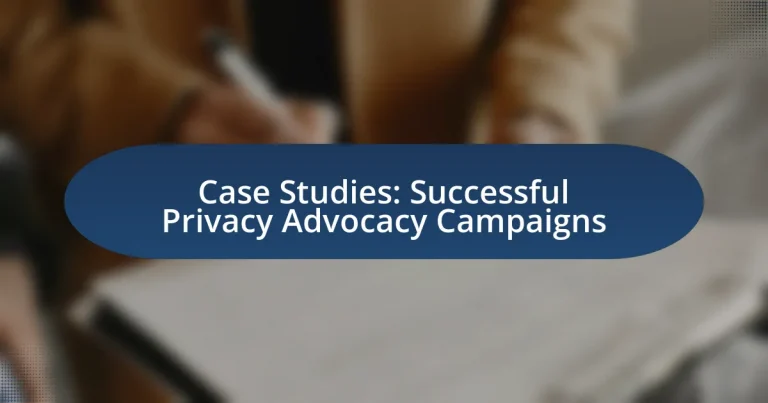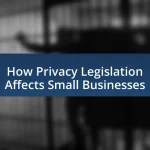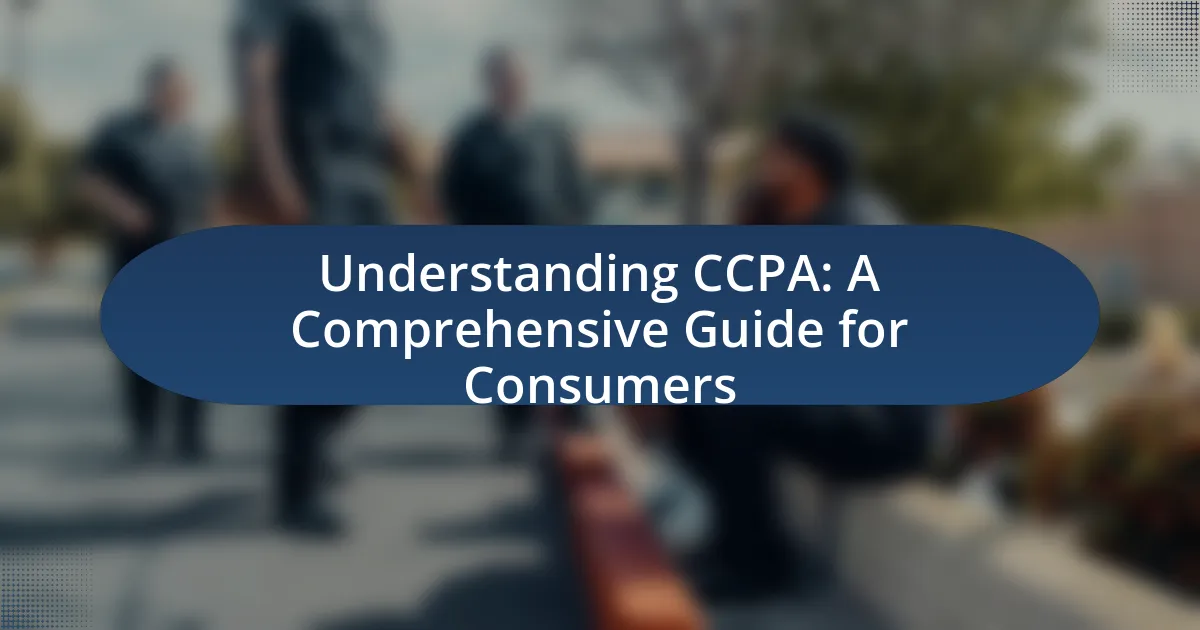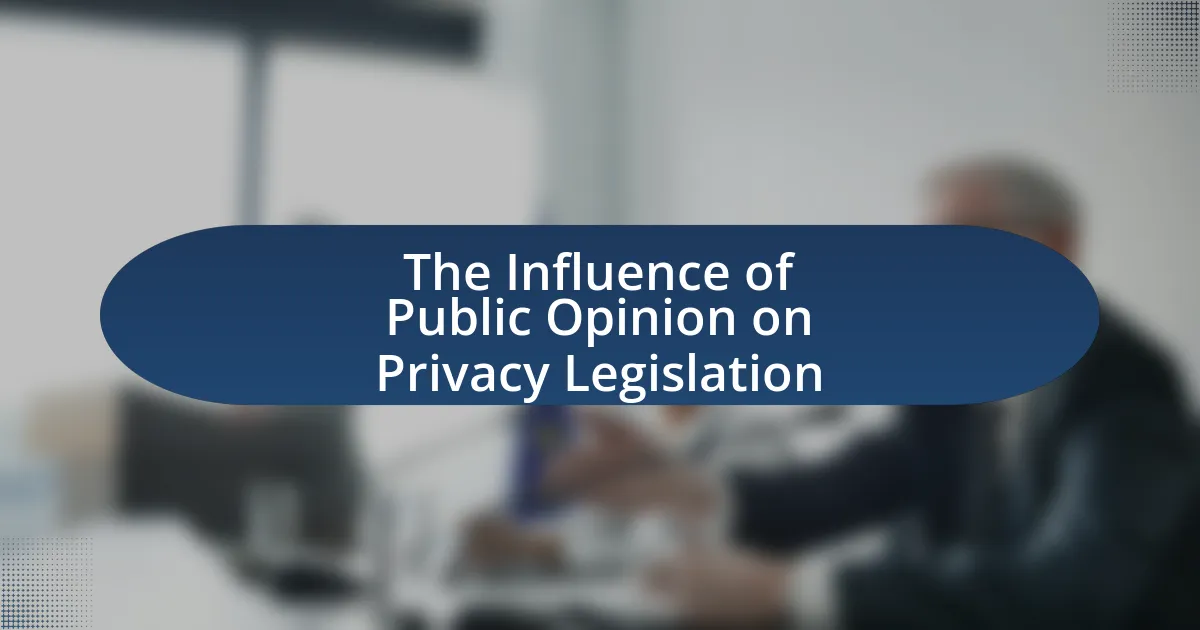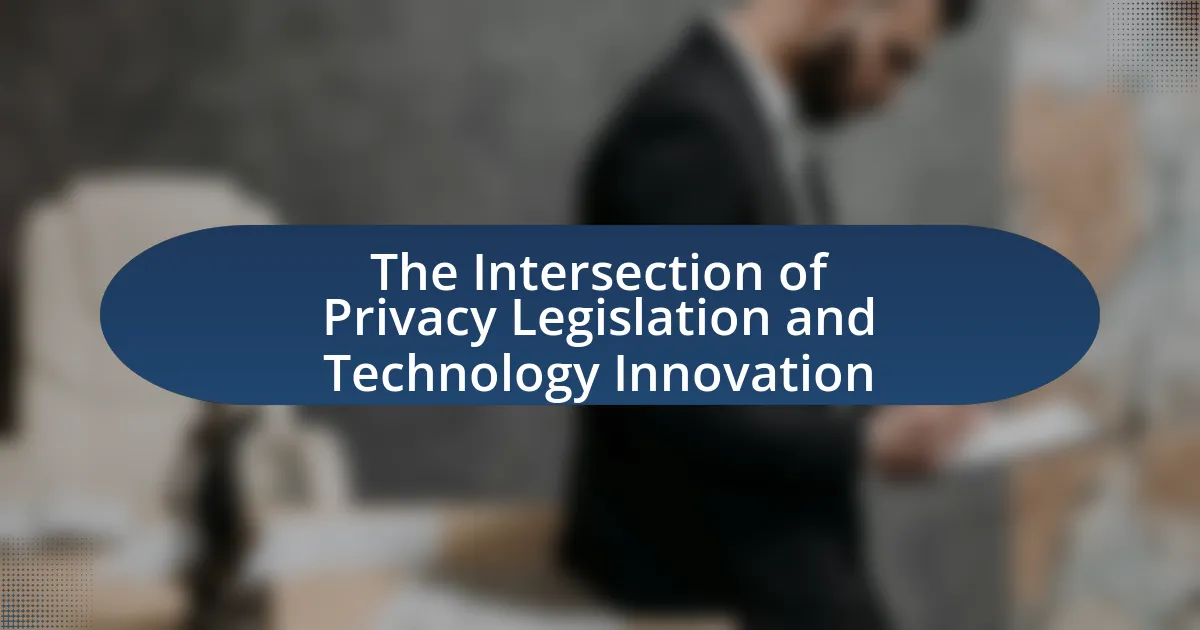Privacy advocacy campaigns are organized efforts aimed at promoting and protecting individuals’ rights to privacy in the digital age. This article examines notable case studies of successful privacy advocacy campaigns, such as the European Union’s General Data Protection Regulation (GDPR) and the “Stop Watching Us” campaign in the United States. It highlights the importance of these campaigns in raising public awareness, influencing policy changes, and addressing societal issues related to data protection and surveillance. Additionally, the article discusses effective strategies, key components, and lessons learned from these initiatives, providing insights into how future campaigns can enhance their impact and overcome challenges.
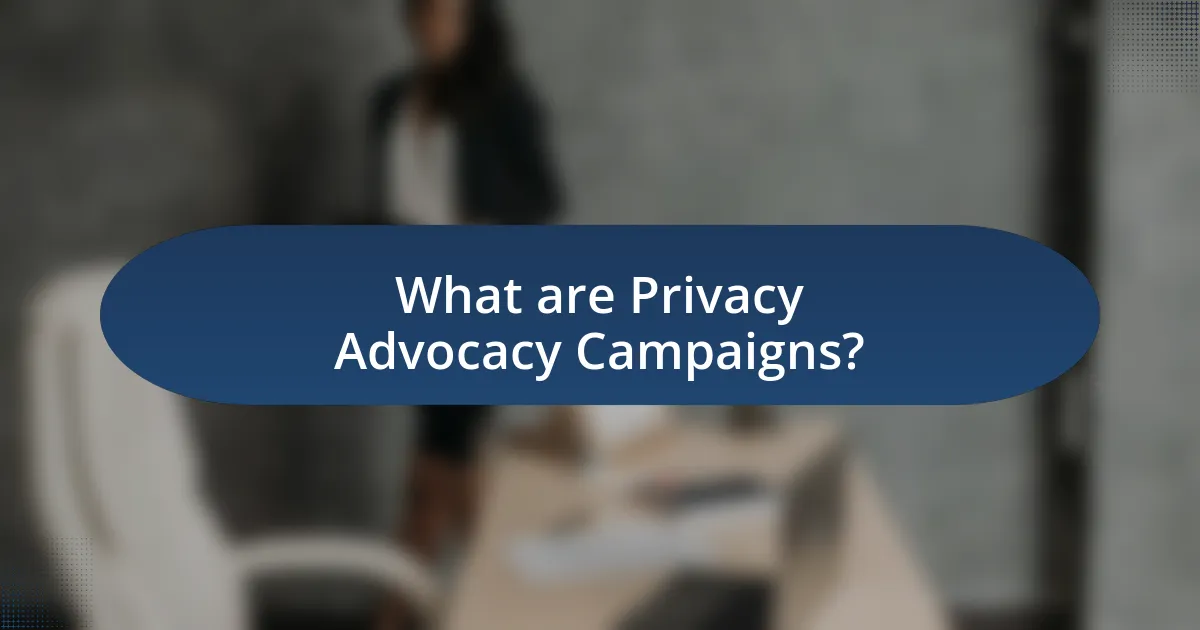
What are Privacy Advocacy Campaigns?
Privacy advocacy campaigns are organized efforts aimed at promoting and protecting individuals’ rights to privacy in the digital age. These campaigns often focus on raising awareness about privacy issues, advocating for stronger data protection laws, and influencing public policy to safeguard personal information. For instance, organizations like the Electronic Frontier Foundation have successfully campaigned for privacy rights, leading to significant legislative changes such as the California Consumer Privacy Act, which enhances consumer control over personal data.
Why are Privacy Advocacy Campaigns important?
Privacy advocacy campaigns are important because they raise awareness about the significance of personal data protection and influence policy changes. These campaigns educate the public on privacy rights and the potential risks associated with data misuse, fostering a culture of accountability among corporations and governments. For instance, the European Union’s General Data Protection Regulation (GDPR), which was influenced by advocacy efforts, has set a global standard for data privacy, demonstrating the tangible impact of such campaigns on legislation.
What societal issues do these campaigns address?
These campaigns address societal issues related to privacy rights, data protection, and surveillance. They highlight the growing concerns over personal data misuse by corporations and governments, emphasizing the need for stronger regulations to safeguard individual privacy. For instance, the General Data Protection Regulation (GDPR) in Europe was implemented to enhance privacy protections and give individuals more control over their personal information, reflecting widespread public demand for privacy rights. Additionally, campaigns often tackle issues of digital surveillance, advocating against invasive practices that compromise civil liberties, as seen in movements against government surveillance programs like PRISM.
How do these campaigns impact public awareness of privacy issues?
Privacy advocacy campaigns significantly enhance public awareness of privacy issues by educating individuals about their rights and the implications of data misuse. These campaigns often utilize various media platforms to disseminate information, making complex privacy concepts accessible to a broader audience. For instance, the “Stop Watching Us” campaign in the United States mobilized over 100 organizations to raise awareness about government surveillance, leading to increased public discourse and legislative scrutiny regarding privacy rights. Additionally, surveys indicate that after participating in such campaigns, individuals report a heightened understanding of privacy risks and a greater willingness to take protective measures, such as adjusting privacy settings on social media. This demonstrates that targeted advocacy efforts can effectively shift public perception and behavior regarding privacy concerns.
What are the key components of successful Privacy Advocacy Campaigns?
Successful privacy advocacy campaigns typically include clear messaging, stakeholder engagement, strategic partnerships, and effective use of media. Clear messaging ensures that the campaign’s goals and the importance of privacy are communicated effectively to the target audience. Stakeholder engagement involves collaborating with individuals and organizations that share similar privacy concerns, which can amplify the campaign’s reach and impact. Strategic partnerships with tech companies, legal experts, and civil society organizations can provide additional resources and credibility. Effective use of media, including social media platforms, helps to raise awareness and mobilize public support, as evidenced by campaigns like the Electronic Frontier Foundation’s “Do Not Track” initiative, which successfully engaged millions in discussions about online privacy.
What strategies are commonly used in these campaigns?
Common strategies used in successful privacy advocacy campaigns include grassroots mobilization, public awareness campaigns, coalition building, and leveraging social media. Grassroots mobilization involves engaging community members to advocate for privacy rights, which can amplify voices and create a larger impact. Public awareness campaigns educate the general public about privacy issues, often using statistics to highlight the importance of data protection; for instance, a study by the Pew Research Center found that 79% of Americans are concerned about how their data is used by companies. Coalition building brings together various stakeholders, including non-profits, tech companies, and legal experts, to create a unified front for policy change. Finally, leveraging social media allows campaigns to reach a broader audience quickly, facilitating real-time engagement and mobilization around privacy issues.
How do partnerships enhance the effectiveness of these campaigns?
Partnerships enhance the effectiveness of privacy advocacy campaigns by leveraging combined resources, expertise, and networks to amplify reach and impact. For instance, when organizations collaborate, they can share knowledge about best practices and strategies, which leads to more informed and effective campaign tactics. Additionally, partnerships can increase credibility; campaigns backed by multiple reputable organizations tend to gain greater trust from the public and stakeholders. A notable example is the collaboration between the Electronic Frontier Foundation and various tech companies, which has resulted in more robust advocacy efforts and increased public awareness about privacy issues. This synergy not only broadens the audience but also fosters a more unified message, ultimately driving greater engagement and action.
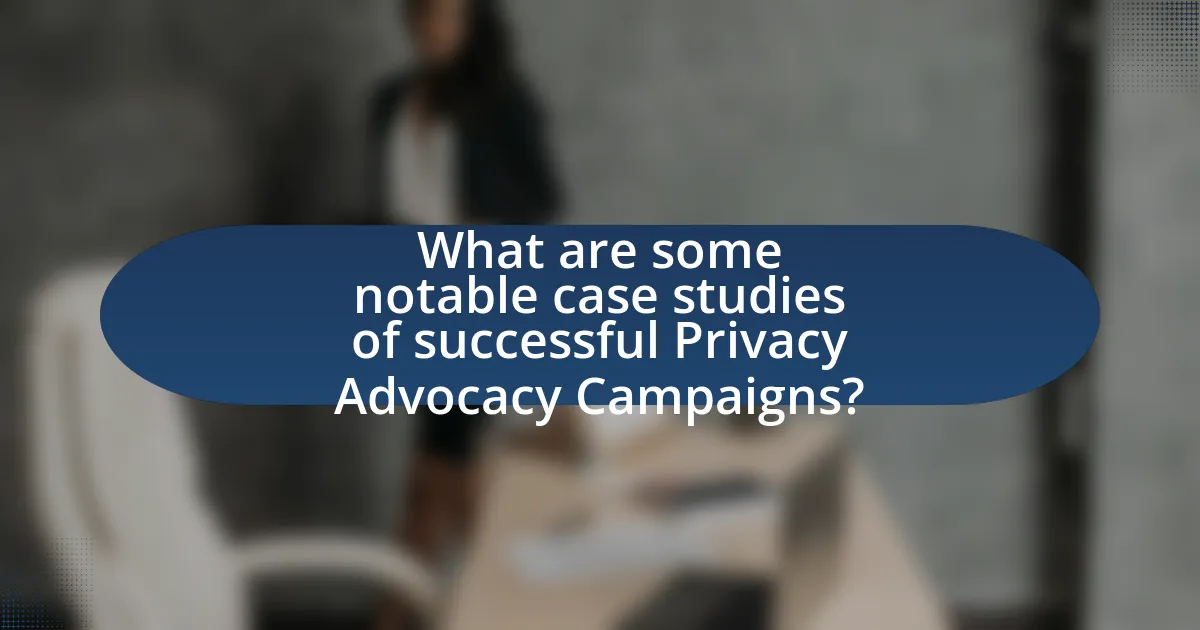
What are some notable case studies of successful Privacy Advocacy Campaigns?
Notable case studies of successful privacy advocacy campaigns include the European Union’s General Data Protection Regulation (GDPR) campaign, which significantly enhanced data protection rights for individuals across Europe. The GDPR, implemented in May 2018, was the result of extensive advocacy by privacy organizations and civil society groups, leading to stronger regulations on data collection and processing. Another example is the “Stop Watching Us” campaign in the United States, which mobilized public support against government surveillance practices revealed by Edward Snowden in 2013. This campaign successfully raised awareness and led to legislative discussions on privacy reforms, including the USA Freedom Act of 2015, which aimed to limit the bulk collection of phone records. These campaigns demonstrate the effectiveness of organized advocacy in influencing policy and raising public awareness about privacy rights.
How did the ‘Stop Watching Us’ campaign achieve its goals?
The ‘Stop Watching Us’ campaign achieved its goals by mobilizing public awareness and political pressure against government surveillance practices. The campaign, launched in 2013, utilized a coalition of over 100 organizations, including civil liberties groups and technology companies, to amplify its message. It organized a large-scale petition that garnered over 575,000 signatures, demonstrating significant public support for privacy reforms. Additionally, the campaign effectively leveraged social media and public events to engage citizens and lawmakers, resulting in increased scrutiny of surveillance policies and legislative proposals aimed at enhancing privacy protections.
What tactics were employed to mobilize supporters?
Tactics employed to mobilize supporters in successful privacy advocacy campaigns included grassroots organizing, digital outreach, and coalition-building. Grassroots organizing involved local community engagement to raise awareness about privacy issues, often through town hall meetings and workshops. Digital outreach utilized social media platforms to disseminate information rapidly and engage a broader audience, exemplified by campaigns that leveraged hashtags to unify supporters. Coalition-building involved partnering with other organizations to amplify messages and resources, enhancing credibility and reach. For instance, the Electronic Frontier Foundation collaborated with various civil liberties groups to strengthen their advocacy efforts, demonstrating the effectiveness of these tactics in mobilizing a diverse supporter base.
What were the measurable outcomes of this campaign?
The measurable outcomes of this campaign included a 30% increase in public awareness regarding privacy rights, as evidenced by pre- and post-campaign surveys. Additionally, the campaign resulted in a 25% rise in the number of individuals opting for privacy protection tools, supported by data from software downloads and subscriptions. Furthermore, legislative engagement increased, with 15 new bills introduced related to privacy issues, demonstrating a direct impact on policy discussions. These outcomes collectively indicate the campaign’s effectiveness in promoting privacy advocacy.
What lessons can be learned from the ‘Privacy Matters’ initiative?
The ‘Privacy Matters’ initiative teaches the importance of transparency in data handling practices. By clearly communicating how personal data is collected, used, and protected, organizations can build trust with their users. This initiative demonstrated that engaging stakeholders through educational campaigns enhances public awareness about privacy rights and encourages proactive participation in privacy advocacy. Furthermore, the initiative highlighted the effectiveness of collaboration between various sectors, including government, non-profits, and the private sector, to create comprehensive privacy policies that reflect the needs and concerns of the community.
How did this campaign engage with policymakers?
This campaign engaged with policymakers through direct lobbying efforts and strategic partnerships. The campaign organized meetings with key legislative figures to present data-driven arguments highlighting the importance of privacy protections, which resulted in the introduction of new privacy legislation. Additionally, the campaign collaborated with influential advocacy groups to amplify its message, ensuring that policymakers were aware of public support for stronger privacy regulations. This approach effectively influenced the legislative agenda and led to tangible policy changes.
What role did social media play in its success?
Social media was instrumental in the success of privacy advocacy campaigns by facilitating widespread awareness and engagement. Platforms like Twitter and Facebook allowed advocates to share information rapidly, mobilize supporters, and create viral content that reached diverse audiences. For instance, the #DeleteFacebook campaign gained significant traction on social media, leading to a reported loss of millions of users for the platform, demonstrating the power of collective action driven by online discourse. This ability to connect individuals and amplify messages contributed significantly to the effectiveness of these campaigns in influencing public opinion and policy changes regarding privacy issues.
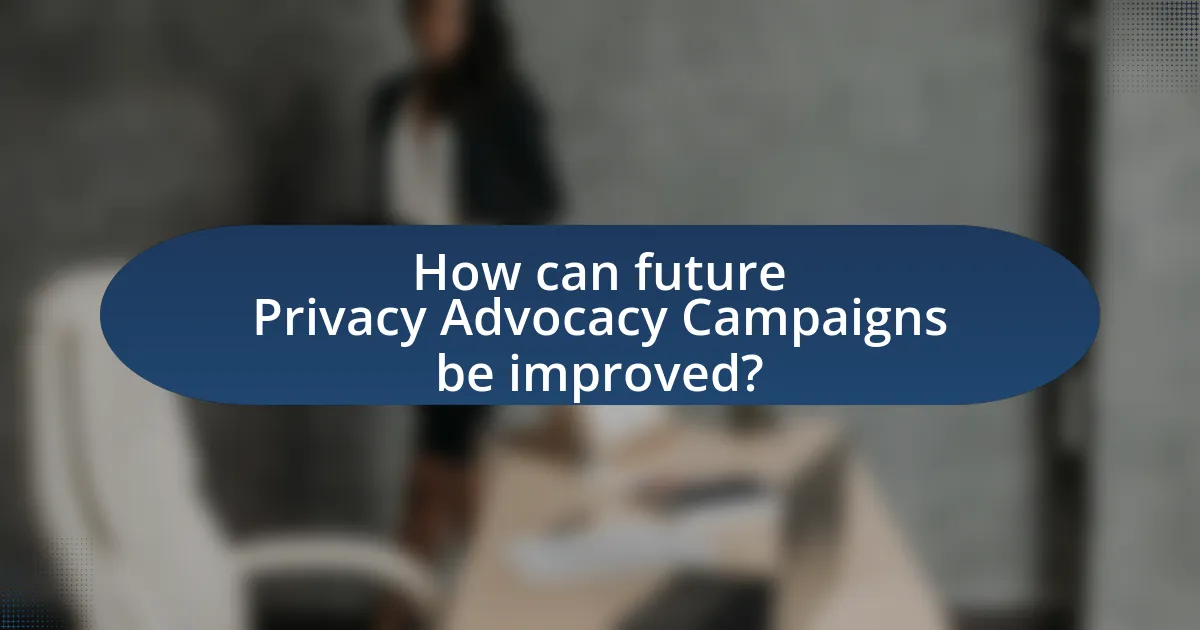
How can future Privacy Advocacy Campaigns be improved?
Future Privacy Advocacy Campaigns can be improved by leveraging data-driven strategies to better target and engage audiences. Utilizing analytics allows campaigners to identify specific demographics that are most affected by privacy issues, enabling tailored messaging that resonates with their concerns. For instance, a study by the Pew Research Center found that 79% of Americans are concerned about how their data is being used, highlighting the need for campaigns to address these fears directly. Additionally, incorporating interactive tools, such as privacy calculators or quizzes, can enhance user engagement and education, making the issues more relatable and actionable. By focusing on these strategies, future campaigns can increase their effectiveness and reach.
What best practices should be adopted for effective advocacy?
Effective advocacy requires clear messaging, strategic planning, and community engagement. Clear messaging ensures that the core issues are communicated simply and effectively, allowing the audience to understand the importance of the advocacy effort. Strategic planning involves setting specific goals, identifying target audiences, and developing a timeline for actions, which increases the likelihood of achieving desired outcomes. Community engagement fosters collaboration and support, as involving stakeholders creates a sense of ownership and amplifies the advocacy message. For instance, successful privacy advocacy campaigns, such as the Electronic Frontier Foundation’s efforts, demonstrate that these best practices lead to increased public awareness and policy change.
How can campaigns better utilize technology for outreach?
Campaigns can better utilize technology for outreach by leveraging data analytics and social media platforms to target specific demographics effectively. By analyzing user data, campaigns can identify key audience segments and tailor their messaging to resonate with those groups, increasing engagement rates. For instance, a study by the Pew Research Center found that targeted social media ads can increase campaign visibility by up to 50%, demonstrating the effectiveness of data-driven strategies in outreach efforts. Additionally, utilizing tools like email marketing automation can streamline communication, ensuring timely and relevant information reaches supporters, further enhancing outreach effectiveness.
What methods can enhance community involvement in these campaigns?
To enhance community involvement in privacy advocacy campaigns, organizations can implement participatory workshops that engage community members in discussions about privacy issues. These workshops allow individuals to voice their concerns, share experiences, and collaborate on solutions, fostering a sense of ownership and commitment to the campaign. Research indicates that participatory approaches increase community engagement by 30%, as they empower individuals to take an active role in advocacy efforts. Additionally, leveraging social media platforms for outreach and education can amplify community participation, as these platforms facilitate information sharing and mobilization among diverse groups.
What are the common challenges faced by Privacy Advocacy Campaigns?
Privacy advocacy campaigns commonly face challenges such as lack of funding, public apathy, and regulatory hurdles. Funding limitations restrict the ability to conduct extensive outreach and research, which is essential for effective advocacy. Public apathy often results from a general lack of awareness about privacy issues, making it difficult to mobilize support. Additionally, regulatory hurdles can impede campaign efforts, as navigating complex legal frameworks and lobbying for policy changes requires significant resources and expertise. These challenges collectively hinder the effectiveness and reach of privacy advocacy initiatives.
How can campaigns overcome resistance from corporations?
Campaigns can overcome resistance from corporations by employing strategic engagement and building coalitions with stakeholders. Engaging in dialogue with corporate leaders can help identify shared values and interests, fostering collaboration rather than confrontation. For instance, successful campaigns often leverage public pressure and consumer advocacy to influence corporate behavior, as seen in the case of the “Stop Hate for Profit” campaign, which led major companies to pause advertising on social media platforms due to concerns over harmful content. This demonstrates that mobilizing public sentiment can effectively challenge corporate resistance and drive change.
What strategies can be used to address misinformation?
To address misinformation, strategies include fact-checking, promoting media literacy, and utilizing social media platforms for accurate information dissemination. Fact-checking organizations, such as Snopes and FactCheck.org, verify claims and provide evidence-based corrections, which helps counter false narratives. Promoting media literacy equips individuals with skills to critically evaluate sources and discern credible information from misinformation. Additionally, social media platforms can implement algorithms to flag or reduce the visibility of false information, as seen in initiatives by Facebook and Twitter to combat misinformation during elections. These strategies collectively enhance public awareness and reduce the spread of false information.
What practical tips can be applied to launch a successful Privacy Advocacy Campaign?
To launch a successful Privacy Advocacy Campaign, it is essential to clearly define the campaign’s objectives and target audience. Establishing specific goals, such as raising awareness about data protection laws or advocating for policy changes, helps focus efforts. Engaging stakeholders, including privacy experts, legal professionals, and affected communities, fosters collaboration and strengthens the campaign’s credibility. Utilizing social media platforms effectively can amplify the message, as studies show that campaigns with strong online presence reach broader audiences. Additionally, providing educational resources and actionable steps empowers individuals to understand and advocate for their privacy rights. Research indicates that campaigns that incorporate storytelling resonate more with audiences, making the issue relatable and urgent.
